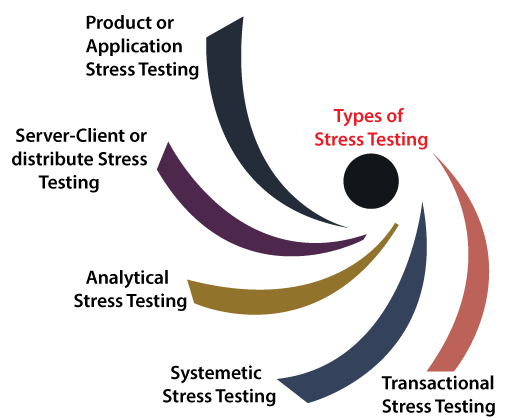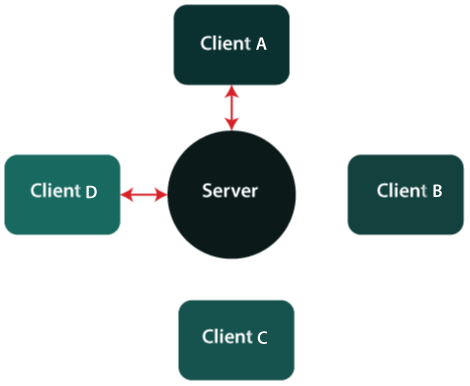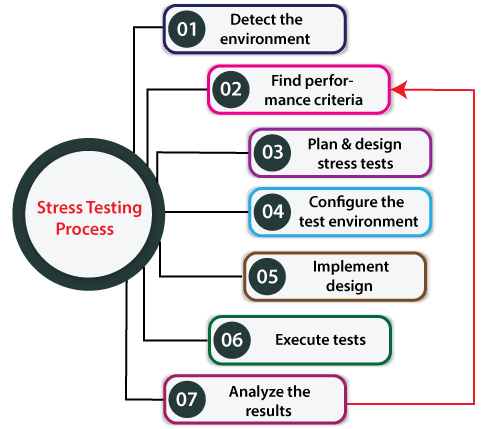Stress Testing
In this section, we are going to understand Stress Testing, which is an important part of Performance testing and used to checks the behavior of an application by applying a load greater than the desired load.
And we also learn about its process, why we need to perform the Stress testing, the objective of Stress testing, examples, various features of stress Testing, advantage and disadvantage.
Introduction of Stress Testing
In software testing, stress testing is an important part of performance testing under non-functional testing.
Stress Testing is testing used to check the accessibility and robustness of software beyond usual functional limits. It mainly considers for critical software but it can also be used for all types of software applications.
It is also known as Endurance Testing, fatigue testing or Torture Testing.
The stress testing includes the testing beyond standard operational size, repeatedly to a breaking point, to get the outputs.
It highlights the error handling and robustness under a heavy load instead of correct behavior under regular conditions.
In other words, we can say that Stress testing is used to verify the constancy and
dependability of the system and also make sure that the system would not crash under disaster circumstances.
To analyses how the system works under extreme conditions, we perform stress testing outside the normal load.
The Objective of Stress Testing
The main objective of using stress testing is to fulfill the following aspects:
- The primary purpose of executing the stress testing is to confirm that the software does not crash in lacking computational resources like disk space, memory, and network request.
- The implementation of stress testing certifies that the system fails and improves effortlessly, known as the recoverability process.
- We can use stress testing to discover hardware issues, data corruption issues.
- Stress testing will help us to identify the security weaknesses that might sneak-in throughout constant peak load.
- It helps determine the software application’s data integrity throughout the extreme load, which implies that the data should be in a dependable state after a failure.
Features of Stress Testing
Following are the basic features of stress testing:
- Stress testing also makes sure that unpredicted failures do not cause security issues.
- It is used to analyze the system works under rare circumstances and the system’s behavior after a failure.
- Stress testing is used to check the system has saved the data before crashing or not.
- Stress testing guarantees to display a suitable error message when the system is under stress.
Why do we need to perform the Stress Testing?
We need to perform stress testing if we encounter the following situations:
Whenever e-commerce or online shopping sites announce a sale during the festival may witness a spike in traffic. Or when an article is mention in a top newspaper, its knowledges an unexpected flow in traffic.
If we fail to assist this sudden traffic can result in loss of profits and status. So, in that case, we need to execute the Stress Testing to integrate such irregular traffic spikes.
Stress testing is also needed to be performed for the below scenarios:
- When the system is under stress, it should display a proper error message.
- To inspect whether the system works under bizarre circumstances.
- If the system is failed under risky situations could result in huge profits loss.
- By implementing Stress Testing, we will be prepared for extreme conditions.
Example of Stress Testing
Let’s see some real-time examples where we can discover the usage of Stress Testing.
Example 1: E-commerce website/ application
Throughout the new product releases, sales, holidays, promotions, and festival offers, the e-commerce application tends to get many users in a very short time.
Example 2: News website at the time of some major/viral event
The news website will crash or slow down when a major event happens; for example, when Michael Jackson passed away, a maximum number of news websites are slow down, or some of them also crashed.
To overcome this situation, we need to perform stress testing on the particular application and be prepared to recover quickly in case of any crashes or failure.
Example 3: Education Board’s result website
Stress testing is important to perform on the education board’s result website. On the day of some results, many students, users, and applicants will logins to the particular to check their grades.
Therefore, the execution of stress testing helps identify the failure of the application and evaluate the performance and recoverability when the ultimate load occurs in a short duration or when the result is out.
Note: Stress testing of the website or an application is very significant to handle such an unexpected increase in several visitors or users.
Types of Stress Testing
Stress testing can be categories into various parts, which are as follows:

- Product or Application stress testing
- Server-client or distribute Stress Testing
- Analytical Stress Testing
- Systematic Stress Testing
- Transactional Stress Testing
Product or Application Stress Testing
- The application or product stress testing is mainly focused on determining the faults related to network issues, data locking, blocking, and a performance bottleneck in a software product.
Server-client or Distribute Stress Testing
- In this type of stress testing, all the clients related to the server are tested.
- The distribute stress testing is used to perform across all clients from the server.
- The server can communicate with clients A and B, but it cannot link with clients C and D when there is stress on the client-server system as we can see in the below image:

Analytical/ Exploratory Stress Testing
- Analytical or exploratory testing is used to execute the system with unusual constraints unlikely to occur in a real scenario.
- It is mainly used to identify the bugs in rare situations such as a large number of users logged simultaneously or a database went offline when retrieved from a website.
Let see some examples of analytical Stress Testing where such irregular conditions are used:
- When a large number of parallel users try to log into the application.
- Data is added in enormously large quantity in the database.
- When the website tries to reach it from the front end, and database linked to the website shuts down.
Systematic Stress Testing
- It is combined testing used to execute the test across various systems running on a similar server.
- Using systematic stress testing, we can easily detect the bottleneck where data of one application blocks another application.
Transactional Stress Testing
- Another type of stress testing is transactional stress testing, which is used to implemented one or more transactions between various applications.
- The main objective of performing the transactional stress testing is to enhance the system performance.
Process of Stress testing / how to perform stress testing
The stress testing process will be completed into the following steps:

Step1: Detect the testing environment
In the first step of stress testing, we will identify the network, software, and hardware configurations and tools available to achieve the stress test.
Step2: Find performance acceptance criteria
After identifying the testing environment, we will find the performance acceptance criteria, which help us categorize the metrics used to test the application’s performance under stress.
And also, identifying the success criteria for a stress test, for example, the maximum load can apply to the application for it to fail.
Step3: Plan and design stress tests
In the next step of the stress testing process, we will plan and design a stress test plan, identify test scenarios etc.
Step4: Configure the test environment
Once the stress test plan has been created successfully, we will move to our next step where we create the test environment, tools and resources essential to perform each approach as features and components become available for test.
Step5: Implement test design
After the test environment’s configuration, we will develop the stress tests resulting the test design best performs.
Step6: Execute tests
In the next step, we will execute the particular test, observe and confirm the tests along with test data and output collection.
Step7: Analyze the results
In the last step of the stress testing process, we will analyze the outcomes, combine and share the respective teams’ output data.
Stress testing tools
As we know that stress testing is part of performance testing, the tools used for performance testing can be used for stress testing.Therefore, we have various types of Stress testing tools available in the market, where some are commercial tools and open-source tools. Some of the most commonly Stress testing are listed below:
- Apache JMeter
- NeoLoad
- Stress tester
- LoadRunner
To get detailed information about the above Stress testing tool, refer to the below link:
https://tutoraspire.com/performance-testing-tools
Advantages and disadvantages of Stress Testing
Advantages
Some of the vital benefits of performing Stress testing is as follows:
- Stress testing signifies the system’s behavior after failure and makes sure that the system recovers quickly from the crashes.
- The most important advantage of executing the stress testing will make the system work in regular and irregular conditions in a suitable way.
- It determines the scalability and enhance the performance of the software.
Disadvantages
Some of the most common drawbacks of Stress testing are as follows:
- Even in open-source tools like JMeter, a load testing environment is required, which should be as close to the production environment setup as possible.
- If we are writing the Stress test script, the person should have enough scripting knowledge of the language supported by the particular tool.
- If we are using stress testing, it will require additional resources, which makes this testing bit costlier.
- If we perform the Stress Testing manually, it became a tedious and complicated task to complete, and it may also not produce the expected results.
Overview
In this tutorial, we have understood that stress testing is used to assess the system under extreme situations. It can verify the system to recover back to normal status.
It is a type of non-functional testing and generally executed after the functional testing.
Stress testing entirely concentrate on testing the system under extreme load situations to detect its breaking point and see if suitable messages are shown when the system is not responsive.
